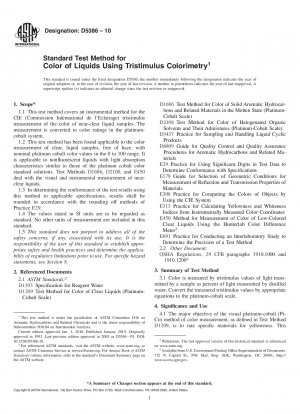ASTM D5386-10
Standard Test Method for Color of Liquids Using Tristimulus Colorimetry
- Standard No.
- ASTM D5386-10
- Release Date
- 2010
- Published By
- American Society for Testing and Materials (ASTM)
- Status
- Replace By
- ASTM D5386-16
- Latest
- ASTM D5386-16
- Scope
The major objective of the visual platinum-cobalt (Pt-Co) method of color measurement, as defined in Test Method D1209, is to rate specific materials for yellowness. This yellowness is frequently the result of the undesirable tendency of liquid hydrocarbons to absorb blue light due to contamination in processing, storage or shipping.
Clear liquids can be rated for light absorbing yellowish or brownish contaminants, using scales that simulate the long-established visual-comparison method just cited. Where needed, dimensions of color can be reported to identify any pinkness or greenness (one dimension), or grayness.
1.1 This test method covers an instrumental method for the CIE (Commission International de l'Eclairage) tristimulus measurement of the color of near-clear liquid samples. The measurement is converted to color ratings in the platinum-cobalt system.
1.2 This test method has been found applicable to the color measurement of clear, liquid samples, free of haze, with nominal platinum cobalt color values in the 0 to 100 range. It is applicable to nonfluorescent liquids with light absorption characteristics similar to those of the platinum cobalt color standard solutions. Test Methods D1686, D2108, and deal with the visual and instrumental measurement of near-clear liquids.
1.3 In determining the conformance of the test results using this method to applicable specifications, results shall be rounded in accordance with the rounding off methods of Practice E29.
1.4 The values stated in SI units are to be regarded as standard. No other units of measurement are included in this standard.
1.5 This standard does not purport to address all of the safety concerns, if any, associated with its use. It is the responsibility of the user of this standard to establish appropriate safety and health practices and determine the applicability of regulatory limitations prior to use. For specific hazard statements, see Section 8.
ASTM D5386-10 Referenced Document
- ASTM D1193 Standard Specification for Reagent Water
- ASTM D1209 Standard Test Method for Color of Clear Liquids (Platinum-Cobalt Scale)
- ASTM D1686 Standard Test Method for Color of Solid Aromatic Hydrocarbons and Related Materials in the Molten State (Platinum-Cobalt Scale)
- ASTM D2108 Standard Test Method for Color of Halogenated Organic Solvents and Their Admixtures (Platinum-Cobalt Scale)
- ASTM D3437 Standard Practice for Sampling and Handling Liquid Cyclic Products
- ASTM D6809 Standard Guide for Quality Control and Quality Assurance Procedures for Aromatic Hydrocarbons and Related Materials
- ASTM E179 Standard Guide for Selection of Geometric Conditions for Measurement of Reflection and Transmission Properties of Materials
- ASTM E29 Standard Practice for Using Significant Digits in Test Data to Determine Conformance with Specifications
- ASTM E308 Standard Practice for Computing the Colors of Objects by Using the CIE System
- ASTM E313 Standard Practice for Calculating Yellowness and Whiteness Indices from Instrumentally Measured Color Coordinates
- ASTM E450 Method for Measurement of Color of Low-Colored Clear Liquids Using the Hunterlab Color Difference Meter
- ASTM E691 Standard Practice for Conducting an Interlaboratory Study to Determine the Precision of a Test Method
ASTM D5386-10 history
- 2016 ASTM D5386-16 Standard Test Method for Color of Liquids Using Tristimulus Colorimetry
- 2010 ASTM D5386-10 Standard Test Method for Color of Liquids Using Tristimulus Colorimetry
- 2005 ASTM D5386-05 Standard Test Method for Color of Liquids Using Tristimulus Colorimetry
- 2004 ASTM D5386-04 Standard Test Method for Color of Liquids Using Tristimulus Colorimetry
- 1993 ASTM D5386-93b(2000)e1 Standard Test Method for Color of Liquids Using Tristimulus Colorimetry
